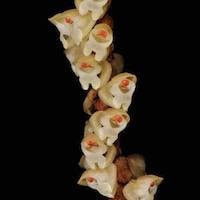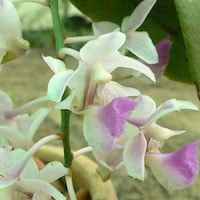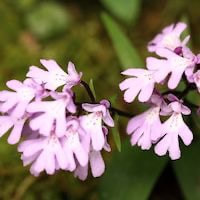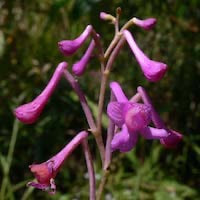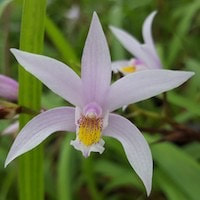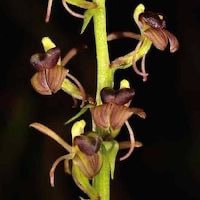MWD6- Men's Woody 6 - The oak culture
|
Native Singaporean Orchid notes: Dendrochilum Magnum
Dendrochilum magnum, known as the "king" of its genus, is an orchid species native to Southeast Asia, particularly the Philippines. It's widely distributed across regions like Panay and Luzon islands. In Singapore, it's common in the wild, gardens, and nurseries. Its fragrance is described as sweet or spicy with a hint of wheat, making it ideal for use in perfumes. This orchid's beauty and appealing scent make it a valuable choice for the Woody 6 (Men)
|
Therapeutic Orchid notes:
|
Pholidota pallida Lindl.
Pholidota pallida, also known as Eumaishixiantao in Chinese, is an orchid species found in regions spanning central Nepal, Bhutan, northeast India, and parts of Southeast Asia. It thrives in forested areas at altitudes ranging from 500 to 2700 meters. In traditional medicine, various parts of Pholidota pallida are used for healing purposes. Its root and pseudobulb paste is applied to reduce fever, while the powdered form aids in inducing sleep and easing abdominal discomfort. The plant's juice is specifically utilized to relieve pain around the navel region. |
|
Aerides falcata Lindl.
Aerides falcata, also known as Zhijia Lan in Chinese and Ueang Kulaab Krapao Perd in Thai, is a fragrant orchid species with clusters of white flowers, each spray containing about 30 blooms. It thrives in Thailand, Indochina, and Myanmar, with no presence further south. In Vietnamese traditional medicine, Aerides falcata serves as a tonic for weak infants. Its seeds are also used to treat boils and skin disorders, aiding in the healing of lesions. |
|
Amitostigma gracile (Blume) Schltr
Amitostigma gracile, also known as Xitingwuzhu Lan, Xiewuzhu Lan, or Huawuzhu Lan in Chinese, and Duyeyizhiqiang in Chinese medicine, is a small terrestrial orchid found in the Himalayas, China, and Japan. It has small underground tubers and is used in traditional Chinese medicine for detoxification, swelling relief, and stopping bleeding. Its parts are boiled or applied externally, and it's also used for treating snake bites and various ailments. |
|
Anthogonium gracile Wall ex Lindl.
Anthogonium gracile, also called Tongban Lan or barrel petal orchid in Chinese, and Honghuaxiaodusuan in Chinese medicine, is a small terrestrial orchid found in Sri Lanka, the eastern Himalayas, and various parts of Southeast Asia. It produces Batatasin III, known for its antifungal properties. In traditional Chinese medicine, it's used for menstrual disorders and pain prevention. Consultation with healthcare professionals is crucial for safe use of plant-based remedies, ensuring proper identification, dosage, and understanding of potential side effects. |
|
Bletilla formosana
Bletilla formosana, known as Taiwanbaiji or hyacinth orchid in Chinese, is a medicinal plant widely used in Traditional Chinese Medicine (TCM). Its stems are valued for their ability to strengthen lungs, stop bleeding, and reduce swelling. In TCM, it treats conditions like tuberculous cough, bronchiectasis, and nosebleeds. In India, stem scrapings heal cracked heels. Active compounds like blestriarene B, a dihydrophenanthrene, contribute antimicrobial properties against bacteria like Staphylococcus aureus and Streptococcus mutans. Using Bletilla formosana should involve consulting healthcare professionals for proper dosage and safety guidelines. |
|
Liparis odorata (Willd.) Lindl. Syn. Liparis paradoxa (Lindl.) Rchb.f.
Liparis odorata, also known as Liparis paradoxa, is a terrestrial herb found in India, Bhutan, Nepal, and China, blooming from April to September. In traditional medicine, it serves various purposes: in India, it treats elephantiasis and is used for fever, edema, burns, and inflammation. Tribals in Karnataka use its pseudobulb for medicinal purposes. In China, it treats flu symptoms, neuritis, leucorrhea, waist discomfort, ulcers, and swelling by dispelling "wind" and "dampness." Healthcare professionals should guide its usage for safety and effectiveness. |
Other scent note
Scentopia Library Reference ingredient
Birch - Check details at Scentopia's scent library
Download the guided mediation that works best with this Orchid fragrance oil
| men_woody_essential_oil_orchi_00006.mp3 | |
| File Size: | 95697 kb |
| File Type: | mp3 |

